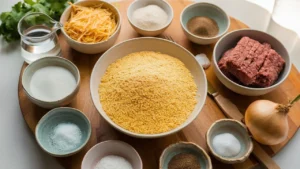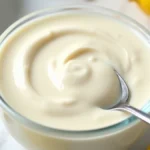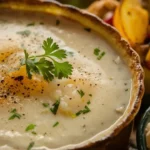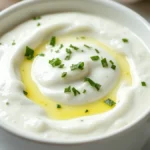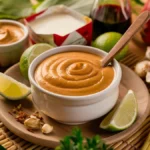Ever wanted a meal that’s both comforting and full of flavor? Cornmeal cakes stuffed with cheese or meat, known as arepas, are here to change your meal game. These South American treats have a crispy outside and a soft inside. They’ll take you straight to the lively kitchens of Colombia and Venezuela.
Arepas are more than a recipe; they’re a cultural adventure in a cornmeal package. Whether you’re into trying new foods or just need a tasty meal, arepas will be your new favorite dish.
Key Takeaways
- Arepas are traditional South American cornmeal cakes stuffed with cheese or meat with endless filling possibilities
- Perfect for gluten-free and vegetarian diets
- Quick and easy to prepare in under 30 minutes
- Versatile dish that can be stuffed with various ingredients
- Authentic recipe using pre-cooked cornmeal (masarepa)
If you’re a fan of crispy, golden cornmeal cakes, you’ll love exploring more stuffed dishes like these classic stuffed cabbage rolls, which share a similar hearty and comforting filling concept.
What Are Arepas: Traditional South American Cornmeal Cakes Stuffed with Cheese or Meat
Arepas are loved cornbread treats from South America. They started hundreds of years ago in Colombia and Venezuela. They are a key part of daily meals.
These round, hearty cornmeal cakes are more than food. They carry deep cultural traditions and culinary heritage across generations.
Origins and Cultural Significance of the Recipe for Cheese or Meat-Stuffed Cornmeal Toast
The Venezuelan and Colombian recipe for cheese or meat-stuffed cornmeal toast has its roots in local cuisine. Local communities prepared it as a nutritious food for long workdays.
- Traditionally made from pre-cooked cornmeal or maize flour
- Central to daily meals across multiple South American countries
- Adaptable to various cooking methods like frying, grilling, and baking
Different Types of Cornmeal Cakes Stuffed with Cheese or Meat recipe
Cornmeal Cakes Stuffed with Cheese or Meat recipe: arepa have many tasty variations, each showing local tastes and ingredients. Some favorites include:
- Arepa de Queso: Cheese-filled version
- Meat-stuffed arepas
- Vegetarian options with avocado or eggs
Regional Variations
While Venezuelan and Colombian arepas share origins, they differ. Colombian arepas are thinner and larger. Venezuelan arepas are thicker and more stuffed.
These stuffed cornbread treats are a beloved culinary treasure. They connect people through shared food experiences.
Essential Ingredients for Perfect Cornmeal Cakes stuffed with cheese or meat
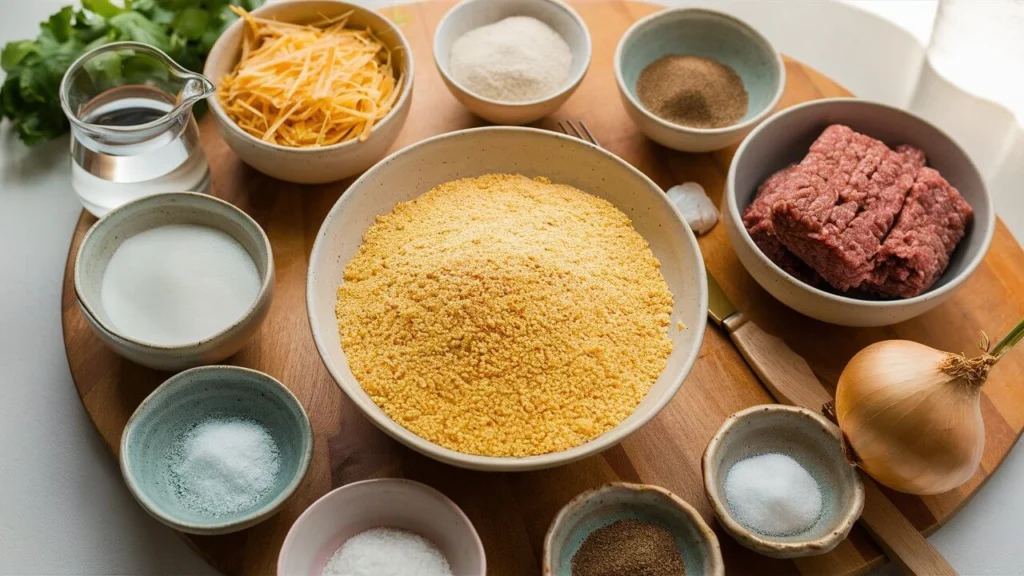
Starting with the right ingredients is key to making great cornmeal cakes. Masa harina is essential for the perfect texture and taste. It’s different from regular cornmeal because it’s pre-cooked. This gives your cakes a unique flavor and texture.
Here are the main ingredients for tasty cornmeal cakes:
- 4 cups white or yellow masa harina
- 3 ½ cups warm water
- 1 teaspoon coarse Kosher salt
- Queso fresco or other cheese for filling
The cheese you pick can change the taste a lot. Queso fresco has a mild, fresh taste that goes well with cornmeal. You can also try other cheeses like cotija or mozzarella for a different flavor.
Other ingredients can make your cornmeal cakes even better:
- Melted butter for a richer taste
- Shredded cheese for more texture
- Herbs or spices for extra depth
Choosing good masa harina is crucial for the authentic taste and texture. Look for brands made specifically for cornmeal cakes. They ensure the right pre-cooking and grinding.
Pro tip: Always check the moisture content and freshness of your masa harina to guarantee the best results in your cornmeal cake preparation.
Cornmeal cakes filled with cheese or meat recipe
Explore Latin American cuisine with this tasty cornmeal cakes recipe. Arepas are cornmeal cakes filled with various delicious ingredients. They’re great for any meal.

Making cornmeal cakes with cheese or meat needs quality ingredients and care. Let’s look at what makes this Latin American dish special.
Base Dough Preparation
To make the perfect base, you’ll need:
- 2 cups masarepa (pre-cooked cornmeal)
- 1¾ cups warm water
- ¼ teaspoon salt
- ½ tablespoon oil
Mixing the ingredients right is key. Knead until the dough is smooth and holds well.
Filling Options and Combinations
Transform your cornmeal cakes with these tasty fillings:
- Cheese Varieties: Manchego, Monterey Jack, mozzarella
- Meat Options: Shredded chicken, ground beef, pulled pork
- Vegetarian Choices: Black beans, avocado, pickled red onions
Cooking Methods
Cooking your cornmeal cakes is easy:
- Form the dough into balls
- Flatten into disc-shaped cakes
- Cook on a griddle or skillet over medium heat
- Flip when golden brown (about 3-4 minutes per side)
Pro tip: Add melted butter and cheese while the arepas are still warm. These cornmeal cakes can be stored for 2-3 days when wrapped in parchment paper and plastic wrap.
This recipe allows for a variety of fillings! Try shredded beef like in this shaved beef steak recipe, or add a cheesy twist inspired by these cheesy garlic chicken wraps.
Choosing the Right Cornmeal: Masarepa vs Regular Cornmeal
When making authentic arepas, picking the right cornmeal is key. Masa harina might seem simple, but not all cornmeal is the same. The secret to great cornmeal cakes is knowing the difference between masarepa and regular cornmeal.
Masarepa, a pre-cooked cornmeal flour, is the top choice for traditional arepas. It has special features that make it different from regular cornmeal:
- Finely ground texture
- Pre-cooked processing
- Softer consistency
- Best for stuffed cornmeal cakes
Regular cornmeal is quite different from masa harina. While it can be used as a substitute, it won’t give you the real arepa taste. The texture will be coarser, and your cakes might not be as soft as they should be.
Where can you find masarepa? Look for brands like P.A.N. in Latin American grocery stores or the international food section of big supermarkets. If masarepa is not available, you can use finely ground cornmeal. But, you might notice some texture differences.
Pro tip: Always check the packaging to ensure you’re buying pre-cooked masa harina specifically designed for arepas.
Your choice of cornmeal greatly affects your arepa experience. Choose quality masa harina, and you’ll make cornmeal cakes that feel like a trip to South America.
For a crispier texture, consider pan-frying these cornmeal cakes, just like you would with these spinach and cheese omelets, which develop a golden, delicious crust.
Step-by-Step Dough Making Process
Making the perfect dough is key for tasty cornmeal cakes. You need to learn a few important steps. These steps turn simple ingredients into a great base for your fillings.

Proper Kneading Techniques
Kneading your dough needs patience and care. Begin by mixing your ingredients well:
- Use 2 cups white cornmeal flour
- Add 2 1/2 cups warm water
- Mix in 2 teaspoons of salt
When kneading, aim for a smooth texture. Work the dough until it forms a tight ball that pulls away from the bowl’s sides. This usually takes 5-7 minutes of steady kneading.
Dough Consistency Tips
Getting the dough right is crucial for your cornmeal cakes. Watch for these signs:
- If the dough is too dry, add warm water slowly
- For sticky dough, add more cornmeal flour
- The dough should form a smooth ball without breaking
Troubleshooting Common Issues
Don’t fret if your dough isn’t perfect at first. Many problems have easy fixes:
- Crumbly dough: Add water, one tablespoon at a time
- Too wet dough: Sprinkle more cornmeal and knead gently
- Uneven texture: Keep kneading until it’s smooth
Let your dough rest for 30 minutes before shaping. This lets the cornmeal soak up fully. It makes your cornmeal cakes more even in texture.
Stuffing and Shaping Techniques
Making the perfect stuffed cornbread needs precision and skill. Start by learning how to prepare the dough and fillings.
Here are the key steps for shaping your stuffed cornbread:
- Divide the dough into 8 equal pieces, ensuring consistent size
- Roll each piece into a smooth ball using your palms
- Gently pat each ball into a 5-inch circular shape
- Wet your hands slightly to prevent sticking during shaping
When adding fillings to your stuffed cornbread, follow these critical guidelines:
- Place 2-3 tablespoons of filling in the center of the dough circle
- Leave a 1/2-inch border around the edge to ensure proper sealing
- Cover with a second dough circle
- Seal edges by pressing gently between your palms
For those wanting to create a pocket-style stuffed cornbread, try this alternative method:
- Make a 1½-inch opening on the side of the arepa
- Cut to the middle without slicing completely through
- Carefully stuff the pocket with your desired filling
- Seal the opening with a small piece of reserved dough
Pro tip: Maintain consistent thickness of about ¼ inch to ensure even cooking and a perfect texture in your stuffed cornbread.
Cooking Methods: Griddle, Pan-Frying, and Baking
Learning to cook corn patties well means knowing different cooking ways. Each method makes your cornmeal cakes taste and feel different. This lets you make tasty corn patties that fit your kitchen and taste.
Corn patties can be cooked in many ways, making cooking fun. The trick is to pick the best method. This way, you get a golden-brown outside and a soft inside.
Griddle Cooking Technique
Griddle cooking is a great way to make corn patties. Here’s how to do it:
- Preheat the griddle to medium heat
- Lightly oil the surface to prevent sticking
- Cook corn patties for 5 minutes per side
- Look for a crispy, golden-brown color
Pan-Frying Method
Pan-frying is another good way to get a crispy corn patty:
- Use a medium-heat skillet
- Add a thin layer of vegetable oil
- Cook 6-7 minutes per side
- Aim for even browning
Baking Option
Baking corn patties in the oven is also a great choice:
- Preheat oven to 350°F (175°C)
- Place corn patties on a baking sheet
- Bake for 10-15 minutes
- Flip halfway through cooking
No matter the method, controlling the temperature and timing is key. This ensures your corn patties are crispy outside and soft inside.
Classic Cheese Filling Variations
Choosing the right cheese can make your arepas amazing. Queso fresco is a top pick, with its mild, fresh taste that pairs well with the cornmeal.
There are many tasty cheese options to try:
- Mozzarella: Provides a smooth, melty texture
- Queso fresco: Offers a traditional, light flavor
- Monterrey Jack: Delivers a creamy, mild taste
- Oaxaca cheese: Creates a stringy, rich filling
Experts say mixing cheeses can make your arepas even better. Jarlsberg is a good base, with some queso fresco for that South American touch.
| Cheese Type | Melting Quality | Flavor Profile |
|---|---|---|
| Queso Fresco | Low | Mild, Fresh |
| Mozzarella | High | Creamy, Smooth |
| Monterrey Jack | Medium | Mild, Buttery |
For a kick, try peppered Jack cheese. The trick is finding the right amount of cheese for your dough. This way, every bite is just right.
Meat Filling Ideas and Preparations
Arepas are a great base for many meat fillings. These cornmeal cakes stuffed with cheese or meat can turn into hearty meals with the right fillings. You’ll discover a variety of protein options that add rich flavors and textures to this South American dish.
Crafting the Perfect Ground Beef Filling
Ground beef is a favorite for arepas. To make a great filling, choose high-quality beef with a bit of fat. This ensures it tastes juicy and full of flavor.
- Brown the ground beef in a skillet with aromatic spices
- Add sofrito for authentic Latin American flavor profile
- Season with organic adobo and additional spices
- Simmer the meat to develop rich, tender texture
Shredded Meat Alternatives
Shredded meats are also great for arepas. Carne Mechada, a slow-cooked shredded beef, is a tasty option. It’s so tender, it just melts in your mouth.
| Meat Type | Preparation Method | Cooking Time |
|---|---|---|
| Carne Mechada | Slow-cooked in broth | 2-3 hours |
| Carnitas | Pressure cooker | 45-60 minutes |
Exploring Pork and Chicken Variations
Beef isn’t the only option. Carnitas and shredded chicken are also delicious. The secret is to season well and cook slowly. This makes the meat tender and flavorful, perfect with the cornmeal cake.
Pro tip: Always reheat your meat gently. Use the stovetop or microwave to keep it moist and prevent it from getting tough.
Storage and Reheating Guidelines
Keeping your cornmeal cakes filled with cheese or meat tasty and fresh is important. Whether you’re making a batch for now or saving some for later, these tips will help. They ensure your arepas stay delicious.
Refrigeration Storage
Store your cornmeal cakes in the fridge. Here’s how:
- Cool the cakes completely before storing
- Wrap each cake in aluminum foil or plastic wrap
- Put them in an airtight container
- Keep them in the fridge for up to 3 days
Freezing Techniques
Freezing is great for keeping your cornmeal cakes fresh for longer:
- Let the cakes cool down to room temperature
- Wrap each one in wax or parchment paper
- Store in a sealed freezer-safe container
- Freeze for up to 3 months
Reheating Methods
| Reheating Method | Temperature | Cooking Time |
|---|---|---|
| Oven | 350°F (176°C) | 10-15 minutes |
| Stovetop Skillet | Medium Heat | 5 minutes per side |
| Air Fryer | 350°F (176°C) | 5 minutes |
For the best texture, preheat your cooking tools and use dry heat. If microwaving, cover with a damp paper towel. Heat in 30-second intervals on medium power.
Remember, the secret to tasty reheated cornmeal cakes is gentle warming and avoiding moisture loss.
Pair these stuffed cornmeal cakes with a refreshing side like this Italian green salad, or go full Latin-inspired with our street corn chicken rice bowl.
Serving Suggestions and Accompaniments
Arepas are a key part of Latin American cuisine. They can make any meal special. These cornmeal cakes are great for any time of day.
You can serve arepas alone or with other dishes. They’re perfect for breakfast, lunch, or dinner. This makes them a fun choice for any meal.
Traditional Side Dishes
Classic Latin American sides can make your arepas even better. Try these:
- Authentic Homemade Refried Black Beans
- Pico de Gallo for a fresh zesty touch
- Tostones (Fried Green Plantains)
- Poached Eggs for added protein
Modern Fusion Pairings
For new flavors, try these modern sides:
- Guacamole for a creamy avocado twist
- Charred Blender Salsa for a spicy kick
- Chimichurri sauce to add herbal complexity
- Simple Sautéed Vegetables for a light contrast
Storage tip: Leftover arepas can be refrigerated for 3-4 days or frozen up to 3 months. This way, you can enjoy them anytime.
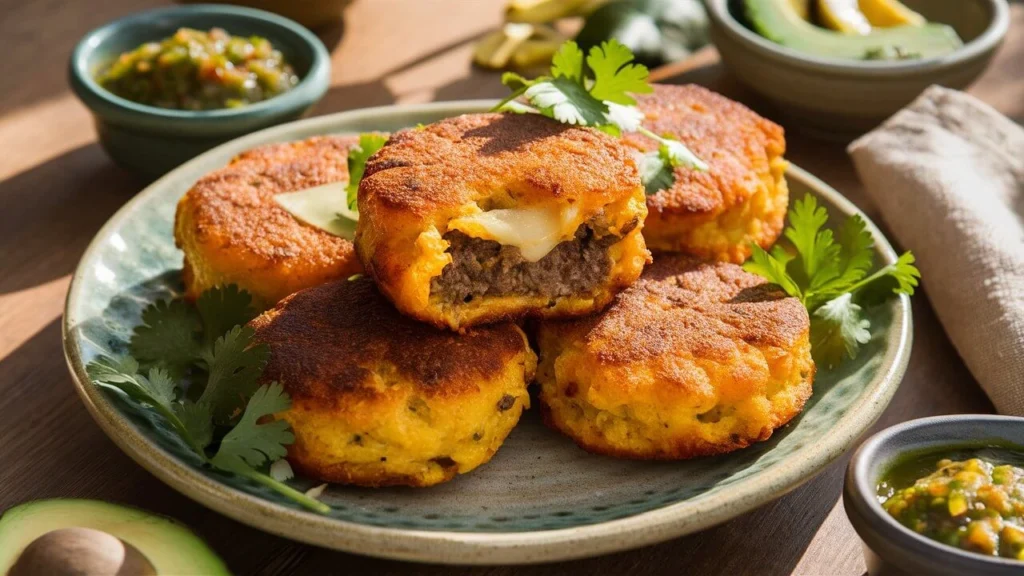
Conclusion for Cornmeal Cakes Stuffed with Cheese or Meat recipe
Venezuelan and Colombian arepas are more than food. They connect you to South America’s rich traditions. You’ve learned about cornmeal cakes filled with cheese or meat.
Learning to make arepas is a journey of flavors and fillings. You can try the crispy Venezuelan style or the softer Colombian one. Now, you can make these tasty cornmeal cakes at home.
Arepas are very versatile. You can fill them with cheese, meat, or even try new, modern fillings. Your culinary adventure is just starting. It’s a celebration of South America’s vibrant flavors and traditions.
If you enjoyed this recipe, be sure to check out our best breakfast recipes for more hearty morning meals!
So, get your masarepa ready and fire up the griddle. Let your creativity flow. Every arepa you make honors the rich culinary heritage that brings people together through food.
FAQ for Cornmeal Cakes Stuffed with Cheese or Meat recipe
What are arepas?
Arepas are traditional South American cornmeal cakes from Venezuela and Colombia. They’re made from pre-cooked cornmeal (masarepa). You can fill them with cheese, meat, or beans.
These corn patties are a big deal in Latin American food. They’re great as a snack, breakfast, or even dinner.
What type of cornmeal should I use for arepas?
Use masarepa, not regular cornmeal or corn flour. Brands like P.A.N. are best for real arepas. Masarepa makes the cakes right and keeps them together while cooking.
How do I know when my arepa dough is the right consistency?
The dough should be smooth and not crack when pressed. It should stick together well and not be too wet or dry. When shaping, it should stay a patty without falling apart.
Your hands should stay clean while handling the dough.
Can I make arepas ahead of time?
Yes, you can make the dough ahead and keep it in the fridge for 1-2 days. You can also freeze uncooked arepas for up to a month. Let them warm up before cooking.
Cooked arepas can be reheated in a skillet or oven to get crispy again.
What are the most popular arepa fillings?
Popular fillings are queso fresco, shredded chicken, ground beef, black beans, and avocado. Venezuelan arepas often have more complex fillings like pabellón.
Colombian arepas are simpler, with just cheese or butter.
Can I make vegetarian arepas?
Absolutely! You can fill them with black beans, roasted veggies, queso fresco, scrambled eggs, avocado, and plant-based proteins. Try spinach and cheese or mushroom and bean fillings.
What cooking methods work best for arepas?
You can cook arepas by griddling, pan-frying, or baking. Griddling or a cast-iron skillet gives the crispiest exterior. Baking is healthier, while pan-frying is a good mix of taste and ease.
Are arepas gluten-free?
Yes, arepas made with masarepa are gluten-free. They’re great for those with gluten issues. Just make sure your fillings are gluten-free too.
How do Venezuelan and Colombian arepas differ?
Venezuelan arepas are bigger and stuffed before or after cooking. Colombian arepas are thinner and might be grilled or fried. Venezuelan arepas are more elaborate, while Colombian ones are simpler.
What should I serve with arepas?
Serve them with salsa, guacamole, beans, fried eggs, and fresh salads. You can also add hot sauce, lime wedges, or enjoy them with coffee. They’re perfect as a meal or a side.
Did You Try Our Recipe ?
There are no reviews yet. Be the first one to write one.
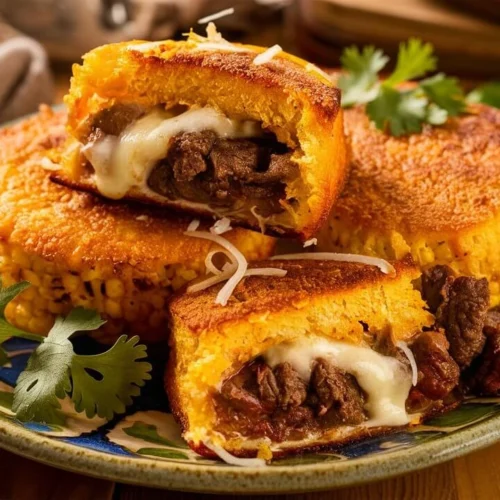
Cornmeal Cakes Stuffed with Cheese or Meat Recipe
Ingredients
For the Dough:
- 2 cups precooked cornmeal masa harina or PAN
- 1½ cups warm water
- ½ teaspoon salt
For Cheese Filling:
- 1½ cups shredded mozzarella queso blanco, or cheddar
For Beef Filling:
- 1 lb ground beef
- 1 small onion chopped
- 1 garlic clove minced
- ½ teaspoon cumin
- Salt and black pepper to taste
Instructions
- 👩🍳 InstructionsPrepare the Dough:Mix precooked cornmeal, warm water, and salt in a bowl. Knead until a soft dough forms. Let it rest for 5 minutes.Cook the Fillings:Cheese Option: Shred and set aside.Beef Option: In a skillet, sauté onion and garlic until soft. Add beef, cumin, salt, and pepper. Cook until browned and fully cooked.Shape the Cakes:Divide the dough into 6–8 balls. Flatten each into a disc, place the filling in the center, and fold the dough over to seal. Gently flatten into patties.Cook the Cakes:Pan-Fry: Heat a skillet with a small amount of oil over medium heat. Cook each cake for 4–5 minutes per side until golden and crisp.Bake: Preheat oven to 375°F (190°C). Place cakes on a baking sheet and bake for 15–18 minutes.Serve Hot:Enjoy with salsa, avocado slices, black beans, or a fresh salad.
Notes
Tips & Notes
- Wet your hands while shaping the dough to prevent sticking.
- Do not overfill or the cakes may split during cooking.
- Use masa harina or precooked cornmeal only—regular cornmeal won’t work.

